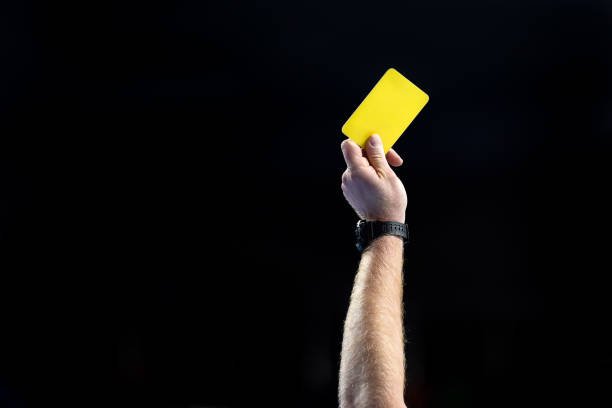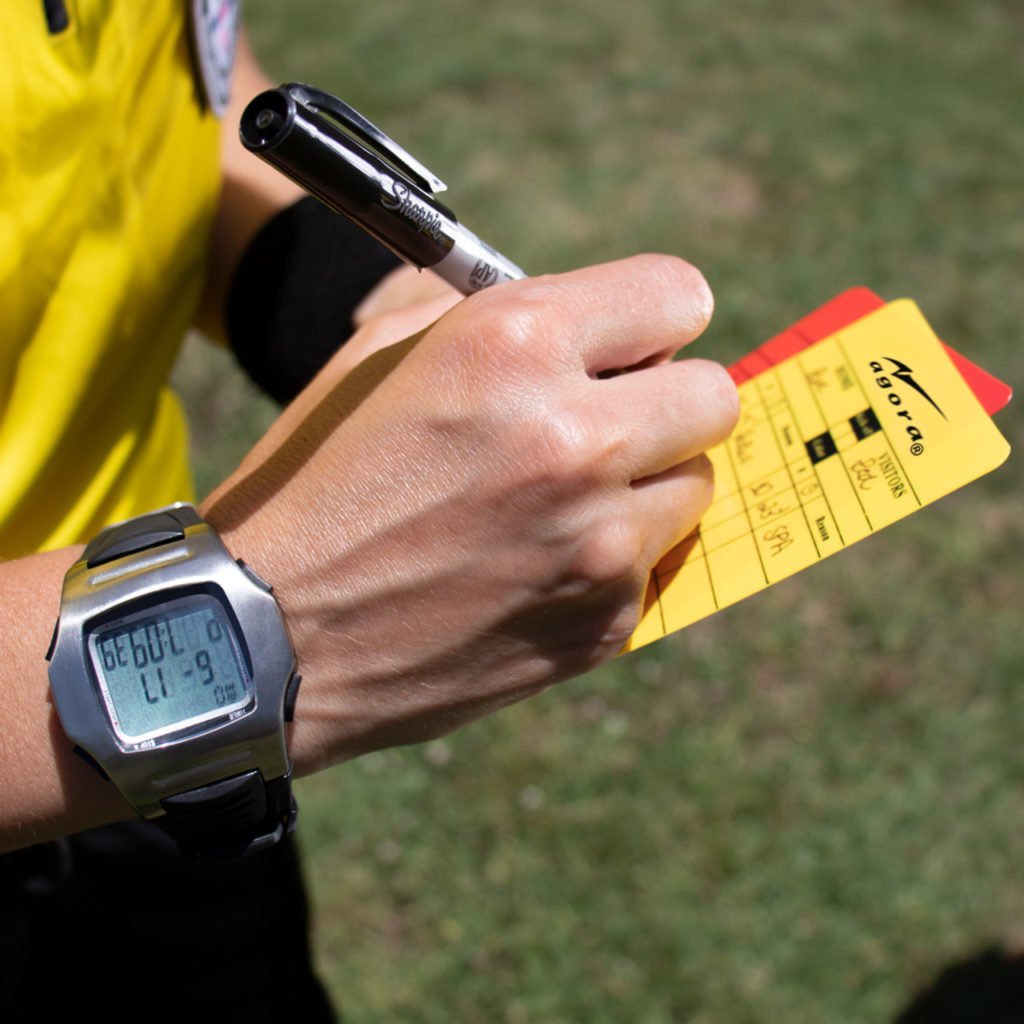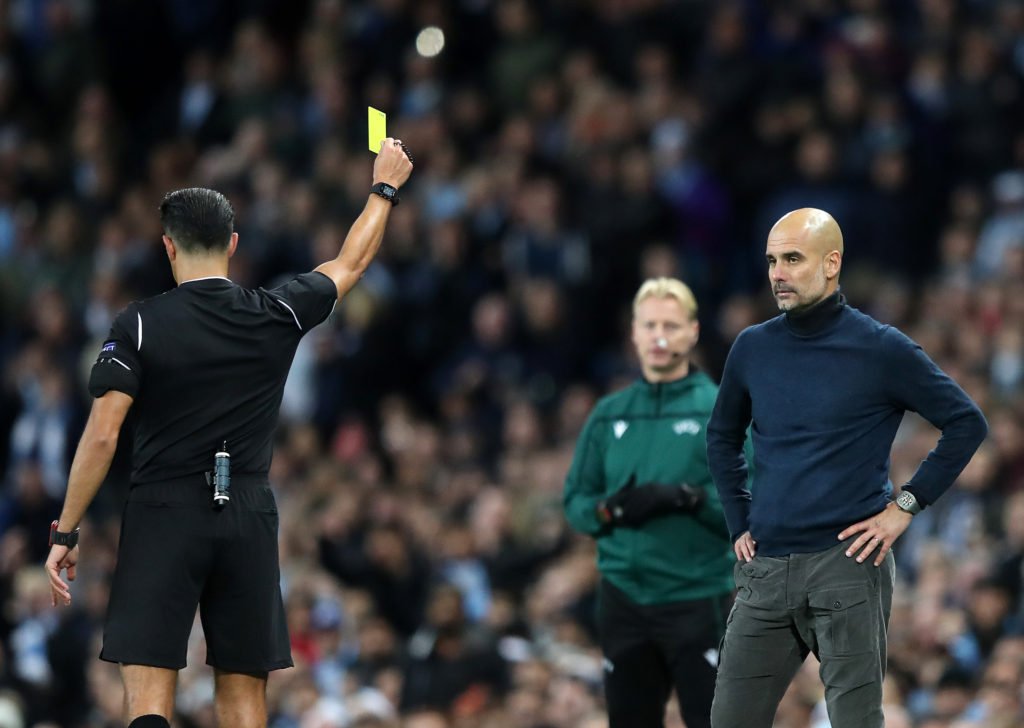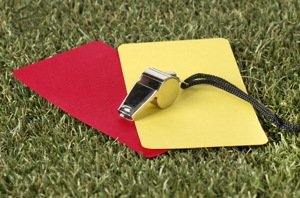- Last Updated -
Soccer Yellow Card ... What Does It Mean?
What Is The Meaning Of A Yellow Card?
In soccer, a yellow card is a disciplinary measure issued by the referee to caution players for various offenses committed during the game [1].
The offenses may include unsporting behavior, dissent, or delaying the restart of the game. When a player receives a yellow card, it is a warning or caution about their conduct on the field. The card signifies that they have been cautioned by the referee in relation to an offense they have committed during the game.
If a player receives two yellow cards in a single game, they must leave the field of play and cannot be replaced. Additionally, players can accumulate yellow cards throughout the season, and if they receive a certain number of cards, they may receive a suspension or ban from future games.
Yellow cards are used to maintain order and fairness on the soccer field, as they discourage players from committing offenses that could potentially harm other players or disrupt the game [4].
They also serve as a warning to players that their conduct is being monitored and may result in more severe disciplinary action if they continue to commit offenses.
How Does A Player Get A Yellow Card?
In soccer, a yellow card is a cautionary warning given to a player by the referee for various types of infractions committed during the game [1].
It is a 3-inch wide and 4-inch long card that is shown to a player to indicate that they have committed an offense and that any subsequent offenses may result in further disciplinary action.
A player can get a yellow card for a variety of reasons. These include fouls, unsporting behavior, consistently infringing the rules of the game, dissenting, or delaying the restart of the game.
Some specific examples of offenses that can result in a yellow card include failing to respect the distance from dropped balls, showing dissent, or illegally touching the ball a second time after a restart, such as a goal kick [3].
When a player commits an offense, the referee will blow their whistle to stop the game’s action, move towards the player who committed the offense, take out the yellow card from their pocket, and present it to the entire field [5].

What Are Some Yellow Card Offenses?
In soccer, a yellow card is a warning given to a player by the referee for a variety of offenses that violate the Laws of the Game.
When a player receives a yellow card, it means that they have committed misconduct and have to be careful not to receive another one, which would result in a red card and expulsion from the game. Here are the most common yellow card offenses in soccer:
1. Reckless play or foul:
If a player commits a reckless play or a foul, such as a high foot or a sliding tackle from behind, the referee may show a yellow card.
2. Unsportsmanlike behavior:
Unsportsmanlike behavior, such as taunting or baiting an opponent, can result in a yellow card [4].
3. Dissent by word or deed:
If a player shows dissent towards the referee or the linesmen, they may receive a yellow card.
4. Repeated infringement of the rules:
If a player commits multiple fouls or violations, the referee may show a yellow card for repeated infringement.
5. Delaying the restart of play:
If a player delays the restart of play, such as by kicking the ball away or not giving it back to the opposing team after a stoppage, the referee may show a yellow card.
6. Entering, re-entering, or deliberately leaving the field of play without the referee’s permission:
If a player enters, re-enters, or deliberately leaves the field of play without the referee’s permission, they may receive a yellow card.
7. Dangerous play:
A player may receive a yellow card for dangerous play, which includes actions such as playing with a raised foot and endangering the safety of an opponent.
It’s important to note that the referee has the final say in deciding whether or not to show a yellow card for a particular offense, and that different leagues and competitions may have slightly different interpretations of the rules.

What Is Unsporting Behavior?
Unsporting behavior in soccer refers to actions taken by a player or team that violate the rules of the game or ethical standards. This can take many forms, including excessive force, deception, and deliberate fouling.
Examples of unsporting behavior include feigning injury or pretending to have been fouled, changing places with the goalkeeper during play without the referee’s permission, committing a direct free kick offense recklessly, and handling the ball to interfere with or stop a promising attack [1].
Unsporting behavior has negative consequences for the game and the players involved. It can lead to injuries, disrupt the flow of the game, and cause unfair advantages for one team over another.
The rules and penalties for unsporting behavior are detailed in Law 12, “Fouls and Misconduct,” of the Laws of the Game. This includes identifying improper behavior and prescribing the penalties to be imposed on individuals for their transgressions [3].
It is important for referees to be vigilant in detecting and punishing unsporting behavior, as it undermines the integrity of the game. Referees are empowered to caution players for unsporting behavior and award indirect free kicks or penalties. If the behavior is particularly egregious, the referee may send the player off the field with a red card [2].
In summary, unsporting behavior in soccer encompasses a variety of actions that violate the rules or ethical standards of the game. The consequences of unsporting behavior can be severe and undermine the integrity of the game. Referees have a critical role in identifying and punishing unsporting behavior to ensure a fair and safe playing environment.

Can A Player Get More Than One Yellow Card?
Yes, a player can receive more than one yellow card in soccer. In fact, if a player receives two yellow cards in a single game, they will be shown a red card and be sent off the field for the remainder of the match.
According to, a yellow card in soccer is issued by the referee to caution a player for unsporting behavior, consistently infringing the rules of the game, dissenting, or delaying the restart of the game.
The yellow card serves as a warning to the player that their behavior is not acceptable and they risk being sent off the field if they continue.
If a player receives a second yellow card during the same game, it is considered a red card offense and they must leave the field immediately.
This means their team will be left with one less player for the remainder of the game, which can significantly impact the outcome.
In conclusion, it is possible for a player to receive more than one yellow card in a soccer game. However, it is important for players to follow the rules of the game and avoid unsporting behavior to prevent being cautioned in the first place.

How Long Does A Yellow Card Last?
A yellow card in soccer is issued by the referee to indicate that a player has committed a foul. It is a disciplinary measure that comes with consequences for the offending player. One question that often comes up is how long a yellow card lasts and what are its effects. Here’s what I found from the provided web search results.
According to Explainsoccer.com, the effect of a yellow card lasts until the end of the game. In other words, the player who receives a yellow card will have to be careful not to commit any more fouls that may warrant a second yellow card or a red card, which would result in their expulsion from the game. However, the severity of the consequences lessens as matches pass by.
It is worth noting that the effect of a yellow card can sometimes last until the end of the competition, especially in tournaments where teams play multiple games over a short period. In such cases, accumulating yellow cards can lead to a player being suspended for a game or more depending on the tournament’s rules.
To summarize, a yellow card’s immediate effect lasts until the end of the game in which it was issued, and the player who receives it must be cautious not to commit any further fouls. However, in some cases, accumulating yellow cards over multiple games can lead to a suspension from future games.
Can Recieving A Yellow Card Carry Over?
When a player receives a yellow card in soccer, it is a warning from the referee for a minor infringement of the rules. However, the consequence of receiving a yellow card can carry over beyond the match in which it was given. A player who accumulates a certain number of yellow cards may be suspended from future matches.
In most leagues and competitions, a player who receives five yellow cards throughout the course of a season will be suspended for the next match. If a player continues to receive yellow cards, the suspension period may increase. In some cases, the accumulation of yellow cards can even lead to a player being banned for several matches.
The consequence of getting a soccer yellow card can also affect the team’s performance. Losing a key player due to suspension can greatly impact the team’s chances of winning future matches. It can also affect team morale, as the players may feel discouraged or frustrated by the absence of their teammates.
What Do Referee’s Write on Yellow Cards?
When a soccer player is shown a yellow card by the referee, it’s important to know what the referee is writing on the card. Referees write several things on yellow cards to document the offense and to help them remember what happened during the match.
Firstly, the referee will write the player’s name and team on the card. This is important to ensure that the right player is identified and the appropriate team is held accountable.
Secondly, the reason for the yellow card is recorded on the card. This could include a variety of offenses, such as unsporting behavior, persistent infringement, or time-wasting [6]. The referee may also make a note of any verbal warnings given before the yellow card was shown.
It’s also possible that the referee may include the time and location of the offense on the card. This is not always necessary, but it can be helpful for record-keeping purposes.
Overall, the information written on yellow cards by soccer referees is intended to provide a clear and concise record of the offense and the player who committed it. By writing down this information, referees can ensure that they are making fair and accurate decisions throughout the match.

Can Managers and Coaches Get Yellow Cards?
Yes, soccer managers and coaches can receive yellow cards during a game. FIFA, the governing body of soccer, has recently introduced a trial for yellow cards for managers and coaching staff [6].
This new rule is designed to improve the behavior of coaches on the sidelines and ensure that they uphold the principles of fair play and respect for the game.
Previously, managers and coaches could be sent off for misconduct, but there was no formal system in place for booking them with yellow or red cards. The introduction of yellow cards for coaches is a step towards ensuring that everyone involved in the game is held accountable for their actions, including those on the sidelines.
The trial for yellow cards for managers and coaching staff is part of a wider set of changes to the Laws of the Game, which also include new rules around goal kicks and substitutions.
It remains to be seen how effective this new rule will be in practice, but it is clear that FIFA is taking steps to improve the behavior of coaches and promote fair play on and off the field.
In conclusion, soccer managers and coaches can receive yellow cards during a game. This new rule introduced by FIFA is aimed at improving their behavior on the sidelines and ensuring that everyone involved in the game is held accountable for their actions [6].

Why Are Soccer Cards Yellow and Red?
Soccer referees use yellow and red cards to indicate different levels of misconduct on the field. Yellow cards typically represent medium-level offenses, and the first yellow card a player receives acts as a warning. If a player accumulates two yellow cards in a single game, it results in a red card, and they are ejected from the match.
The player cannot be substituted out, and the team plays short a player for the rest of the game. In contrast, red cards are used for more severe offenses, and a player receiving one is automatically ejected from the match without any prior warning [2].
Yellow cards and red cards were first introduced in the 1970 World Cup in Mexico, and they quickly became an essential tool for referees to control the game.
The reason why they are yellow and red is that these colors are easily distinguishable on the field and can be seen from a distance by players, coaches, and fans alike.
In conclusion, yellow and red cards are a crucial aspect of soccer games that help referees maintain control over the game by punishing misconduct on the field.
Yellow cards are given for medium-level offenses, while red cards are for more severe violations, and the two yellow cards will result in a red card. These cards are colored yellow and red to make them visible from a distance and distinguishable on the field.

Soccer Yellow Card Conclusion
In conclusion, a yellow card in soccer is a disciplinary measure used by referees to caution players for various offenses during the game. The card is used to maintain order and fairness while promoting fair play and sportsmanship among players.
A player can receive a yellow card for various reasons, including unsporting behavior, consistently infringing the rules of the game, dissenting, or delaying the restart of the game. If a player receives two yellow cards in a game, they must leave the field of play.
Some common yellow card offenses in soccer include reckless play or foul, unsportsmanlike behavior, dissent, repeated infringement of the rules, delaying the restart of play, entering, re-entering, or deliberately leaving the field of play without the referee’s permission, and dangerous play.
Unsporting behavior is a particularly concerning offense that has negative consequences for the game and the players involved. It is important for referees to be vigilant in detecting and punishing unsporting behavior to maintain the integrity of the game.
Overall, the yellow card is an essential aspect of soccer that helps to maintain the game’s fairness and order while ensuring players’ safety.
FAQs - Soccer Yellow Card
What is a Yellow Card in Soccer?
- A yellow card is a disciplinary measure by referees to caution players for various offenses during the game, including unsporting behavior, dissent, or delaying the game’s restart.
How is a Yellow Card Issued?
- Referees issue a yellow card as a cautionary warning for infractions like fouls, unsporting behavior, dissent, or delaying the game’s restart. Specific offenses include disrespecting the distance from dropped balls or illegally touching the ball after a restart.
What are Common Yellow Card Offenses?
- Common offenses include reckless play, unsporting behavior, dissent, repeatedly infringing the rules, delaying the game’s restart, unauthorized field entry, or exit, and dangerous play.
What Constitutes Unsporting Behavior?
- This includes actions violating game rules or ethical standards, like excessive force, deception, feigning injury, changing places with the goalkeeper without permission, and handling the ball to stop an attack.
Can a Player Receive More Than One Yellow Card?
- Yes, receiving two yellow cards in a single game results in a red card and expulsion from the match.
How Long Does a Yellow Card Last?
- The effect lasts until the game’s end. Accumulating yellow cards over multiple games can lead to suspension from future games.
Can Yellow Card Consequences Carry Over?
- Yes, accumulating a certain number of yellow cards may lead to suspension from future matches.
What Do Referees Write on Yellow Cards?
- Referees note the player’s name, team, the reason for the card, and possibly the time and location of the offense.
Can Managers and Coaches Get Yellow Cards?
- FIFA has introduced a trial for issuing yellow cards to managers and coaching staff to improve sideline behavior.
Why are Soccer Cards Yellow and Red?
- Yellow cards signal medium-level offenses and act as a warning. Red cards are for more severe offenses and lead to immediate ejection from the match.
Introduction: Demystifying a Controversial Issue Soccer is a sport that requires specific...
Read More
















